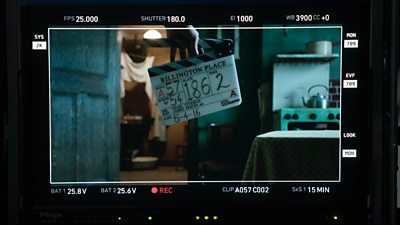Interview with Craig Viveiros
A chilling three-part drama, Rillington Place is based on the real-life multiple murders carried out by John Christie in Notting Hill in the 1940’s and 50’s.

We suddenly found ourselves walking through the set realising that every single little nook and cranny and door and piece of furniture had actually been recreated to exactly the same specifications.
What made you want to be involved in the project?
Rillington Place is one of the most famous miscarriages of justice in British history. I’ve been aware of the case for some time and it’s always intrigued me, purely just on the miscarriage of justice for Tim Evans, Christie’s next door neighbour. As soon as I heard that Sharon Bloom and Phillippa Giles were making Rillington Place, it was definitely something that piqued my interest and I knew I’d be keen to be involved.
What were your first thoughts on reading the scripts?
My immediate reaction to the scripts was that Tracey and Ed had done a great job in creating a new and interesting take on an already interpreted story by dividing it up into three parts, and creating a triptych with the stories of Ethel, Tim Evans and John Christie all in their own separate facets. Telling the story this way through a single person’s perspective allowed us to be bolder in how we told it.
How did you feel about taking on a true story?
In all storytellings, sometimes there’s poetic licence and the aim of telling a good story prevents the truth from being present but in this case myself, Tim, Sam, Nico, Jodie, the writers and producers, were all concerned that we had to be sensitive in this case. There are still family members who are alive from Tim Evans’ family and they suffer the pain of this everyday. It has to be dealt with in a very sensitive and delicate way but you have to tell the truth of the story. These people really suffered at the hands of this man and I think it’s important people are aware of what he did and see the true horror of it.
How was it working with such an incredible cast?
The cast of Rillington Place have been amazing, starting off with of course the dark heart of the story, John Christie, played by Tim Roth who I think has given one of his career best performances to date. He’s done an absolutely amazing job in bringing this character to life and preserving the truth of Christie and the understated simmering horror and presence.
Samantha Morton gave everything to Ethel. I could not have asked for anything more. The power that she has on screen, you’re unable to take your eyes off her and you really feel the pain of Ethel. It’s a difficult one to convey seeing as there’s such ambivalence as to her involvement in the case but you really feel her suffering.
Nico Mirallegro was an absolute joy. He’s one of the most amazing young actors I’ve had the pleasure of working with. He really, really sings from the heart and every performance he gives just continues to blow me away.
What was your ambition for the visual look for Rillington Place?
The aim was to have quite a simple outlook and vision for Rillington Place. It’s a true story. It deals with fact and I wanted the vision to lend itself to that. Every single member of the crew in terms of the creative roles, the production designer, cinematographer, costume designer, were given the brief to start with the reality of Rillington Place. We looked at images from the case, documentation from newspapers of the time to more recent reports, investigations and other pieces that were put together for this notorious case. The portraits by a hyper-realist painter called Richard Tuschman were something that influenced me quite heavily in terms of how I was going to photograph the world of Rillington.
BAFTA winner Pat Campbell designed the set. How was it working with her?
Our production designer has done an amazing job with the piece. There was a moment where Tim Roth and I were shooting in the kitchen and we found a cross-section of the house in an old monthly real-life interest magazine. We suddenly found ourselves walking through the set realising that every single little nook and cranny and door and piece of furniture had actually been recreated to exactly the same specifications. You had to pinch yourself sometimes.
Would you agree that Rillington Place is itself a character in the story?
Rillington Place is a character in the story and it’s always been that way. It’s almost as if Christie had found this perfect house, the end of a terrace, where there was no return. He wanted seclusion but he also wanted anonymity in a place like London where you can go incognito under your Trilby, walking through the crowds. Christie’s ability to hide in plain sight at all times. Rillington Place itself was poor, it was a slum, and he could project an image of himself that was a middle class upstanding member of the community. In truth, that was all a façade.

